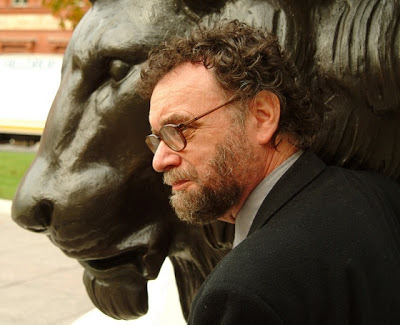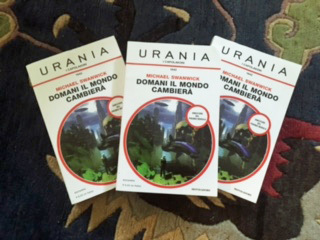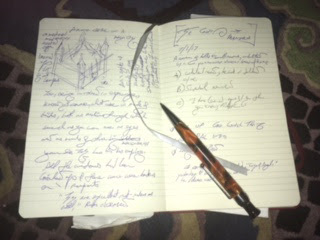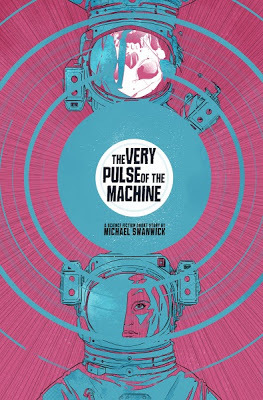Michael Swanwick's Blog, page 97
August 10, 2017
Chitchat in Helsinki
.

Worldcon 75. I arrived in Helsinki at 2 p.m. and by nightfall had been in conversations with so many people that if I mentioned a fraction of them, you'd think I was a name dropper.
The fact, for example, that Marianne and I were sitting at a table in the al fresco cafe outside the convention center with Shawna McCarthy and Pat Cadigan and Ellen Datlow and Eileen Gunn and a batch of other witty and congenial folk when Robert Silverberg stopped by to schmooze.
Or the conversation I had at the Chinese Fandom party with Ruhan Zhang and Bao Shu and my friend of ten years' standing, Haihong Zhao, about the current state of science fiction in China.
Or...
But ya know what? It's been a long, long, jet-lagged day and I'm fading fast. Hitting the sack now. Regret that. Hope your every day is as good as this one has been for me.
More to come.
Above: The drink that won a competition for best gin and tonic in Europe. Its secret? Frozen lingonberries and a sprig of rosemary. Pat Cadigan looks on in admiration.
*

Worldcon 75. I arrived in Helsinki at 2 p.m. and by nightfall had been in conversations with so many people that if I mentioned a fraction of them, you'd think I was a name dropper.
The fact, for example, that Marianne and I were sitting at a table in the al fresco cafe outside the convention center with Shawna McCarthy and Pat Cadigan and Ellen Datlow and Eileen Gunn and a batch of other witty and congenial folk when Robert Silverberg stopped by to schmooze.
Or the conversation I had at the Chinese Fandom party with Ruhan Zhang and Bao Shu and my friend of ten years' standing, Haihong Zhao, about the current state of science fiction in China.
Or...
But ya know what? It's been a long, long, jet-lagged day and I'm fading fast. Hitting the sack now. Regret that. Hope your every day is as good as this one has been for me.
More to come.
Above: The drink that won a competition for best gin and tonic in Europe. Its secret? Frozen lingonberries and a sprig of rosemary. Pat Cadigan looks on in admiration.
*
Published on August 10, 2017 12:59
August 3, 2017
In Which I Explain Everything There Is To Be Explained
.

I've been interviewed for Reach . The interview covers a lot of territory from what The Iron Dragon's Mother is about to how I plot, my favorite blurb, what there is to be learned from James Branch Cabell, etc., etc. Here's a fairly typical call-and-response:
Can you send us an image of your writer workspace? Do you even have one of those outdoor workshed style writer workspace or do you have the old school, extended library office? Writer's workspaces are a kind of a popular fetish for making into a man-cave or princess-room that all wannabe writers and fans want to see what their favorite authors look like in their natural habitat. What are your most important work tools and reference books or inspirational favorite sci-fi authors in your personal workspace?
MS: I have an extremely cluttered home office – photographer Kyle Cassidy uses it as the standard of untidiness – filled with memorabilia (a bundle of rope samples from a factory in Kolomna, a West African sword, globes of real and imaginary worlds, trophies, Swanwick-brand soup cans that Jason Van Hollander made for me, and so on), drifts of paper from dozens of projects, various tools of the trade, and of course shelf upon shelf of books – most of them double-stacked and almost all non-fiction. (Fiction and poetry are shelved elsewhere.) Marianne calls it a wizard’s den.
Basic reference works kept by the desk are a thesaurus, a standard dictionary, Barlett’s Familiar Quotations, and the Oxford English Dictionary – the condensed version that you have to use a magnifying glass to read. Close to hand are various foreign dictionaries and specialized reference books on fairies, saints, demons, and so on. Plus lots and lots of books on the sciences, religion, folklore, whatever. A pretty standard batch, really, for a writer.
I also have a “devil stone” that a Siberian shaman gave me, to unlock my powers he said. When I don’t feel like working, I hold it in my hand to remind myself of all the things and experiences my writing has brought me.
You can find the entire interview here.
Above: My favorite author photo ever. By Beth Gwinn. You can find her home page here.
*

I've been interviewed for Reach . The interview covers a lot of territory from what The Iron Dragon's Mother is about to how I plot, my favorite blurb, what there is to be learned from James Branch Cabell, etc., etc. Here's a fairly typical call-and-response:
Can you send us an image of your writer workspace? Do you even have one of those outdoor workshed style writer workspace or do you have the old school, extended library office? Writer's workspaces are a kind of a popular fetish for making into a man-cave or princess-room that all wannabe writers and fans want to see what their favorite authors look like in their natural habitat. What are your most important work tools and reference books or inspirational favorite sci-fi authors in your personal workspace?
MS: I have an extremely cluttered home office – photographer Kyle Cassidy uses it as the standard of untidiness – filled with memorabilia (a bundle of rope samples from a factory in Kolomna, a West African sword, globes of real and imaginary worlds, trophies, Swanwick-brand soup cans that Jason Van Hollander made for me, and so on), drifts of paper from dozens of projects, various tools of the trade, and of course shelf upon shelf of books – most of them double-stacked and almost all non-fiction. (Fiction and poetry are shelved elsewhere.) Marianne calls it a wizard’s den.
Basic reference works kept by the desk are a thesaurus, a standard dictionary, Barlett’s Familiar Quotations, and the Oxford English Dictionary – the condensed version that you have to use a magnifying glass to read. Close to hand are various foreign dictionaries and specialized reference books on fairies, saints, demons, and so on. Plus lots and lots of books on the sciences, religion, folklore, whatever. A pretty standard batch, really, for a writer.
I also have a “devil stone” that a Siberian shaman gave me, to unlock my powers he said. When I don’t feel like working, I hold it in my hand to remind myself of all the things and experiences my writing has brought me.
You can find the entire interview here.
Above: My favorite author photo ever. By Beth Gwinn. You can find her home page here.
*
Published on August 03, 2017 07:30
August 2, 2017
Simplify, Simplify, Simplify!
.

Long-time readers of this blog know that when I have absolutely no news to convey and yet feel obligated to post (I have been remiss in recent weeks, and am anxious to get back on schedule), I offer writing advice for new writers.
Today's advice: Simplify.
There is a story and it should be told in the absolute minimum number of words possible. Kurt Vonnegut once wrote that in fiction every sentence should reveal character or advance the action. Those are words to live by.
Unsuccessful stories are full of digressions. They begin by "setting the scene" -- rip all that out. The protagonist comments on things that have nothing to do with the story and do not clarify his or her character. That goes too.
Cut.
Cut.
Cut.
Cut.
Then take a sponge and mop up as much of the blood as you can.If you've done it right, what remains will be lean, lovely, and compelling.
You're probably wondering now how to tell when you've cut too much. Don't worry about it. In all my decades of reading, I only ever ran into one published story where the author had taken out more than he should have -- and he was a very skilled writer indeed, one of the best.
That's all for today. But it's enough to keep you occupied for a long, long time.
Above: Some pretty flowers. They don't advance the action. But they do reveal something about my character.
*

Long-time readers of this blog know that when I have absolutely no news to convey and yet feel obligated to post (I have been remiss in recent weeks, and am anxious to get back on schedule), I offer writing advice for new writers.
Today's advice: Simplify.
There is a story and it should be told in the absolute minimum number of words possible. Kurt Vonnegut once wrote that in fiction every sentence should reveal character or advance the action. Those are words to live by.
Unsuccessful stories are full of digressions. They begin by "setting the scene" -- rip all that out. The protagonist comments on things that have nothing to do with the story and do not clarify his or her character. That goes too.
Cut.
Cut.
Cut.
Cut.
Then take a sponge and mop up as much of the blood as you can.If you've done it right, what remains will be lean, lovely, and compelling.
You're probably wondering now how to tell when you've cut too much. Don't worry about it. In all my decades of reading, I only ever ran into one published story where the author had taken out more than he should have -- and he was a very skilled writer indeed, one of the best.
That's all for today. But it's enough to keep you occupied for a long, long time.
Above: Some pretty flowers. They don't advance the action. But they do reveal something about my character.
*
Published on August 02, 2017 14:38
July 31, 2017
And In Some Distant Future...
.

How do you like my headstone? That's it above.
Marianne and I went to West Laurel Hill Cemetery today and bought two plots in their "green" section. Not that we're planning on using them anytime soon. But making these arrangements is the sort of things adults do to save the next generation a lot of bother when our time comes.
The green section of the cemetery is a field of wildflowers, essentially. People are buried there in biodegradable coffins or just a linen shroud, either cremated or whole but unembalmed. Their names with dates of birth and death are carved into a low stone wall nearby. Several beehives are located nearby to pollinate the flowers and once a year some goats are brought in to crop the dead plants down to the ground. No headstones, no plastic flowers, or even jewelry allowed. Eventually, trees will grow up and there will be a small patch of woodland abutting the more conventional (and quite beautiful) cemetery grounds. And in some distant future, perhaps, a fox will dig its burrow among what once were my bones.
I like the quiet lack of fuss of that.
And on a sillier note...
Here are some shots that Marianne took of me dancing by my grave.




Above: The thing about the fox? I live in a Philadelphia neighborhood called Roxborough. It's named that because the first settlers came here in the seventeenth century, before the invention of the log cabin. So they dug caves into the banks of the Wissahickon Creek and put wooden facades over the front to house them until they could build real houses. A visitor wrote back to England that the people here built "burrows in the rocks like foxes." And the rocks-burrow name stuck.
*

How do you like my headstone? That's it above.
Marianne and I went to West Laurel Hill Cemetery today and bought two plots in their "green" section. Not that we're planning on using them anytime soon. But making these arrangements is the sort of things adults do to save the next generation a lot of bother when our time comes.
The green section of the cemetery is a field of wildflowers, essentially. People are buried there in biodegradable coffins or just a linen shroud, either cremated or whole but unembalmed. Their names with dates of birth and death are carved into a low stone wall nearby. Several beehives are located nearby to pollinate the flowers and once a year some goats are brought in to crop the dead plants down to the ground. No headstones, no plastic flowers, or even jewelry allowed. Eventually, trees will grow up and there will be a small patch of woodland abutting the more conventional (and quite beautiful) cemetery grounds. And in some distant future, perhaps, a fox will dig its burrow among what once were my bones.
I like the quiet lack of fuss of that.
And on a sillier note...
Here are some shots that Marianne took of me dancing by my grave.




Above: The thing about the fox? I live in a Philadelphia neighborhood called Roxborough. It's named that because the first settlers came here in the seventeenth century, before the invention of the log cabin. So they dug caves into the banks of the Wissahickon Creek and put wooden facades over the front to house them until they could build real houses. A visitor wrote back to England that the people here built "burrows in the rocks like foxes." And the rocks-burrow name stuck.
*
Published on July 31, 2017 14:45
July 27, 2017
Domani il Mondo Cambiera
.

Look what arrived in the mail today! Mondadori has published a new paperback edition of Domani il Mondo Cambiera. Which, in the original English, is my novel Stations of the Tide. Translated by Marco Pinna. Cover art by Andrea Falsetti.
And that's pretty much all I can say about it. Like most Americans I am, alas, monolingual. At least I have the decency to be ashamed of this fact.
And if you're going to be in Chengdu this November...
I'll be a guest at the Fourth China (Chengdu) International SF Conference on 10th through 12th of November in Chengdu, China. Science Fiction World has its offices in Chengdu and I am proud to say that they have published many of my stories over the years. So I am particularly delighted to be returning for a third time to the home of the famous thatched hut of the poet Du Fu.
If you're going to be at the convention, be sure to say hello.
*

Look what arrived in the mail today! Mondadori has published a new paperback edition of Domani il Mondo Cambiera. Which, in the original English, is my novel Stations of the Tide. Translated by Marco Pinna. Cover art by Andrea Falsetti.
And that's pretty much all I can say about it. Like most Americans I am, alas, monolingual. At least I have the decency to be ashamed of this fact.
And if you're going to be in Chengdu this November...
I'll be a guest at the Fourth China (Chengdu) International SF Conference on 10th through 12th of November in Chengdu, China. Science Fiction World has its offices in Chengdu and I am proud to say that they have published many of my stories over the years. So I am particularly delighted to be returning for a third time to the home of the famous thatched hut of the poet Du Fu.
If you're going to be at the convention, be sure to say hello.
*
Published on July 27, 2017 09:45
July 14, 2017
Friday's Dream Diary
.I'm off to Readercon in a few minutes -- perhaps I'll see you there? So today's blogpost will, alas, be perfunctory. But I've been so dilatory in recent weeks that I felt it would be wrong to just blow it off.
I have a dozen irons in the fire right now, at a modest estimate: I'm working on a new Darger & Surplus story, a new Mongolian Wizard story, two extremely interesting collaborations with other writers, a raft of other independent stories, a couple of essays, plus any number of hard-to-describe projects. You'll be hearing about them all over the coming year.
Right now, just to include something less (though not a great deal less) vague, here's my...
Dream Diary (July 14, 2017):
I dreamed I was working a crossword puzzle whose clues had no words but only brightly colored cartoons. I had no problem with "fruit" or "volcano" or "The Monkees." But the cartoon of a woman singing into a microphone stumped me. Christine Aguilera, perhaps? The older I get, the more unfair pop culture clues seem to me.
Above: Yes, it wasn't a very interesting dream. But the point of dream diaries is to keep track of everything and then, at some later point, put them all together and see what can be learned. This is how I discovered that, yes, people can dream in color and, no, it's not true that one never dreams tastes or scents.
*
I have a dozen irons in the fire right now, at a modest estimate: I'm working on a new Darger & Surplus story, a new Mongolian Wizard story, two extremely interesting collaborations with other writers, a raft of other independent stories, a couple of essays, plus any number of hard-to-describe projects. You'll be hearing about them all over the coming year.
Right now, just to include something less (though not a great deal less) vague, here's my...
Dream Diary (July 14, 2017):
I dreamed I was working a crossword puzzle whose clues had no words but only brightly colored cartoons. I had no problem with "fruit" or "volcano" or "The Monkees." But the cartoon of a woman singing into a microphone stumped me. Christine Aguilera, perhaps? The older I get, the more unfair pop culture clues seem to me.
Above: Yes, it wasn't a very interesting dream. But the point of dream diaries is to keep track of everything and then, at some later point, put them all together and see what can be learned. This is how I discovered that, yes, people can dream in color and, no, it's not true that one never dreams tastes or scents.
*
Published on July 14, 2017 05:06
July 3, 2017
Back to Short Fiction
.

The Iron Dragon's Mother is finished and off in the world. So, while I proceed to research the next book, I have time to work on short fiction. I have a few dozen stories I want to finish with six or seven right at the top of my list.
Pictured above are my notes for one of those stories.
Which I'll get to work on in two minutes.
And as promised...
I'll have my travel notes for Tampere written up soon. Really. This time I mean it.
*

The Iron Dragon's Mother is finished and off in the world. So, while I proceed to research the next book, I have time to work on short fiction. I have a few dozen stories I want to finish with six or seven right at the top of my list.
Pictured above are my notes for one of those stories.
Which I'll get to work on in two minutes.
And as promised...
I'll have my travel notes for Tampere written up soon. Really. This time I mean it.
*
Published on July 03, 2017 09:42
June 26, 2017
A Real Cover for an Imaginary Book
.

Look what Manuel Preitano made -- just for the joy of it!
Preitano is an Italian artist and author. Among many other accomplishments, he did the cover for Gli Dei di Mosca, the Italian edition of Dancing With Bears. And this is not the only time he's shared a bit of whimsy with me. Last year, he reimagined Beelzebub the cat from my story "Of Finest Scarlet Was Her Gown" (a line from which became the title of Not So Much, Said the Cat, my most recent collection) as an anthropomorphic grifter -- a feline rival, perhaps, for arch-conman Surplus. So I have been an admirer of his work for some time.
If you haven't read "The Very Pulse of the Machine," you can't appreciate what a shrewd piece of design this is. It captures the gist of the story in a single striking image. More than that, it captures the feel of it.That can't be easy.
And that's all. I just wanted to share this with you, so you can join in my admiration of the artist.
You can see the cover for Gli Dei di Mosca here.
You can see the portrait of Beelzebub here.
And you can find Manuel Preitano's home page with many examples of his work in the gallery here.
And coming soon...
Regular readers of this blog know that I've been giving travel tips for those going to Finland this summer. This week, I'll be doing a two-parter covering what may be the strangest way to spend an afternoon you can have in that beautiful country.
Hint (and this gives away the game to anyone who knows Finland): It takes place in Tampere.
*

Look what Manuel Preitano made -- just for the joy of it!
Preitano is an Italian artist and author. Among many other accomplishments, he did the cover for Gli Dei di Mosca, the Italian edition of Dancing With Bears. And this is not the only time he's shared a bit of whimsy with me. Last year, he reimagined Beelzebub the cat from my story "Of Finest Scarlet Was Her Gown" (a line from which became the title of Not So Much, Said the Cat, my most recent collection) as an anthropomorphic grifter -- a feline rival, perhaps, for arch-conman Surplus. So I have been an admirer of his work for some time.
If you haven't read "The Very Pulse of the Machine," you can't appreciate what a shrewd piece of design this is. It captures the gist of the story in a single striking image. More than that, it captures the feel of it.That can't be easy.
And that's all. I just wanted to share this with you, so you can join in my admiration of the artist.
You can see the cover for Gli Dei di Mosca here.
You can see the portrait of Beelzebub here.
And you can find Manuel Preitano's home page with many examples of his work in the gallery here.
And coming soon...
Regular readers of this blog know that I've been giving travel tips for those going to Finland this summer. This week, I'll be doing a two-parter covering what may be the strangest way to spend an afternoon you can have in that beautiful country.
Hint (and this gives away the game to anyone who knows Finland): It takes place in Tampere.
*
Published on June 26, 2017 08:03
June 21, 2017
American Names
.

I was on the road recently and posted on Facebook (Marianne was driving at the time):
All of which was good clean fun. (Though if you live in Pennsylvania you will, after a few decades, grow tired of hearing people snicker about Intercourse and Bird in Hand.) (Not that I kept myself from snickering when I was in Dildo, Newfoundland, so let's not put on airs here.) But I really wasn't making fun of those names, or if I was only a little bit. There is an honest, plain-spoken beauty to old American names. Even a kind of poetry.
Here's an excerpt (with a couple of sentences cut off of the first paragraph) fro a story I wrote titled "Mother Grasshopper":
That was the intent, anyway. It fit the story, which was a strange one. But I'm going to share a minor secret here: All those names are of places in Pennsylvania.
Why did I do that? Because I could, mostly. Because even though they were from a single state, they sounded like they were scattered across America. And because as long as you're writing a story, you might as well leave a few Easter eggs behind, to amuse those few who happen to notice.
*

I was on the road recently and posted on Facebook (Marianne was driving at the time):
What a country this is for names! Mud Turnpike. Clums Corner. Farm to Market Road. Cropseyville. Quakenkill (river). Dyken Pond. Pickleville Road. Little Hoosic River. Bee Hill. All within a few miles of each other.Which was responsible not only for our visiting a friend who lived nearby and noticed we were driving through, but also for over fifty comments on Funny Names People Have Known.
All of which was good clean fun. (Though if you live in Pennsylvania you will, after a few decades, grow tired of hearing people snicker about Intercourse and Bird in Hand.) (Not that I kept myself from snickering when I was in Dildo, Newfoundland, so let's not put on airs here.) But I really wasn't making fun of those names, or if I was only a little bit. There is an honest, plain-spoken beauty to old American names. Even a kind of poetry.
Here's an excerpt (with a couple of sentences cut off of the first paragraph) fro a story I wrote titled "Mother Grasshopper":
Our business entailed constant travel. We went to Brinkerton with cholera and to Roxborough with typhus. We passed through Denver and Venice and Saint Petersburg and left behind fleas, rats, and plague. In Upper Black Eddy, it was ebola. We never stayed long enough to see the results of our work, but I read the newspapers afterwards, and it was about what you would expect…I hope you can hear the music there. I was trying to evoke the homely rhythms of the plains states, where you can get on an intersection and drive all night, while periodically an exit sign drifts by for Berlin or Paris or Vienna or London, so that eventually you begin to hallucinate that you got onto the wrong road and are traveling one with off-tamps to all the major cities of the Earth.
We walked to Tylersburg, Rutledge, and Uniontown and took wagons to Shoemakersville, Confluence, and South Gibson. Booked onto steam trains for Mount Lebanon, Mount Bethel, Mount Aetna, and Mount Nebo and diesel trains to McKeesport, Reinholds Station, and Broomall. Boarded buses to Carbondale, Feasterville, June Bug, and Lincoln Falls. Caught commuter flights to Paradise, Nickel Mines, Niantic, and Zion. The time passed quickly.
That was the intent, anyway. It fit the story, which was a strange one. But I'm going to share a minor secret here: All those names are of places in Pennsylvania.
Why did I do that? Because I could, mostly. Because even though they were from a single state, they sounded like they were scattered across America. And because as long as you're writing a story, you might as well leave a few Easter eggs behind, to amuse those few who happen to notice.
*
Published on June 21, 2017 00:30
June 20, 2017
Touring Finland: Old Rauma
.

As long as you're going to Helsinki for the Worldcon, why not make a vacation out of it? Finland is a beautiful country and the one tie I visited it, I loved every minute of it.
This is part of a continuing series.
Old Rauma is a UNESCO World Heritage Site, one of seven in Finland, and is quite possibly the single most laid-back to tour. It consists of some six hundred buildings in the core of the town, built between the Eighteenth and Nineteenth Centuries. (The city is much older but, as with so many other wooden cities, there was a fire.) The streets were laid out in medieval times, so they tend to be narrow and the buildings are vernacular -- in the style of earlier times. They are painted a variety of colors: reds, greens, yellows, blues, and ochres.
Rauma is a living city and most of the houses are inhabited, so you can't go tromping about in people's yards. But in a warm human touch, many people place items in their windows for decoration. I thought that very generous of them.
In Helsinki Square, there is a statue titled The Lace-Maker , a memorial to the fact that Rauma was once a lace-making center. But the pleasure in visiting Old Rauma is not historical but simply the gentleness of the experience: spending a few hours wandering about and getting to know a very old city, and gaining some sense of its soul.
I found the above photo at the Visit Helsinki site, which has tourist information far superior to anything I can give you. I believe (I could be wrong, though) that's the market square at the center of Old Rauma. But really the joy of the place is wandering through its medieval-narrow streets, seeing what there is to b seen.
You can explore the English-language version of the site here.
You can read what UNESCO had to say about it here.
*

As long as you're going to Helsinki for the Worldcon, why not make a vacation out of it? Finland is a beautiful country and the one tie I visited it, I loved every minute of it.
This is part of a continuing series.
Old Rauma is a UNESCO World Heritage Site, one of seven in Finland, and is quite possibly the single most laid-back to tour. It consists of some six hundred buildings in the core of the town, built between the Eighteenth and Nineteenth Centuries. (The city is much older but, as with so many other wooden cities, there was a fire.) The streets were laid out in medieval times, so they tend to be narrow and the buildings are vernacular -- in the style of earlier times. They are painted a variety of colors: reds, greens, yellows, blues, and ochres.
Rauma is a living city and most of the houses are inhabited, so you can't go tromping about in people's yards. But in a warm human touch, many people place items in their windows for decoration. I thought that very generous of them.
In Helsinki Square, there is a statue titled The Lace-Maker , a memorial to the fact that Rauma was once a lace-making center. But the pleasure in visiting Old Rauma is not historical but simply the gentleness of the experience: spending a few hours wandering about and getting to know a very old city, and gaining some sense of its soul.
I found the above photo at the Visit Helsinki site, which has tourist information far superior to anything I can give you. I believe (I could be wrong, though) that's the market square at the center of Old Rauma. But really the joy of the place is wandering through its medieval-narrow streets, seeing what there is to b seen.
You can explore the English-language version of the site here.
You can read what UNESCO had to say about it here.
*
Published on June 20, 2017 08:09
Michael Swanwick's Blog
- Michael Swanwick's profile
- 546 followers
Michael Swanwick isn't a Goodreads Author
(yet),
but they
do have a blog,
so here are some recent posts imported from
their feed.



